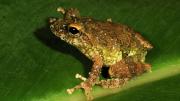The Harvard University Museum of Comparative Zoology is one of the oldest museums in the United States–but part of its immense collection remains tucked away, constantly in use but never displayed to the public.
Hidden below those towering floors of animals from around the world is the Herpetology Collection, containing approximately 345,000 preserved specimens, including around 152,600 amphibians and 194,900 reptiles. Agassiz professor of zoology James Hanken, curator of herpetology in the Museum of Comparative Zoology (MCZ), is responsible for curating this massive repository of preserved frogs, lizards, snakes, salamanders, caecilians, and more.
Hanken is many things: a scientist who employs cutting-edge technology to study amphibian morphology and population change, a field researcher who has travelled on expeditions throughout the world, and the former director of the MCZ.
Although the numbers vary, it is estimated that around one-third to one half of all amphibian species are threatened with extinction. This collection, housing tens of thousands of animals, represents a crucial research tool and barometer for tracking species change.
In this video, Hanken explains the causes and status of the ongoing amphibian extinction crisis, including his own work within the field.
Watch the full interview here.
All frog photos by S. D. Biju.
Fieldwork photos and portrait of James Hanken by A. J. Joji.
Read James Hanken’s profile of Louis Agassiz, founding director of Harvard’s Museum of Comparative Zoology:
https://www.harvardmagazine.com/2013/04/a-scientist-in-full
Read more about Hanken's work:
https://www.harvardmagazine.com/2008/11/world-wide-web-of-life-html
https://www.harvardmagazine.com/2005/09/scanning-species-html
https://www.harvardmagazine.com/2020/08/blaschka-3d-sea-creatures
Read more about the amphibian extinction crisis:
https://www.harvardmagazine.com/2003/03/of-ants-and-earth-html
Support amphibian conservation efforts:









